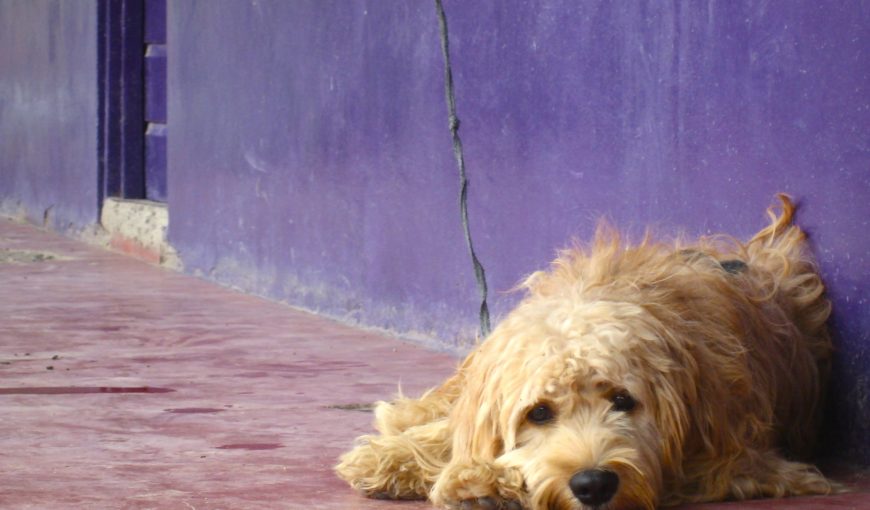Lost Dogs

Prevention is best to keep your dog home and safe.
Try to prevent escapes by ensuring that fences and gates are secured and in good repair. Dogs can
squirm out of gaps in fences, open loose gates, will dig under a fence. Some very small dogs can fit between gateposts even when the gate is secure.
Be sure exterior doors and screens are secure. Something really exciting outside like a squirrel or the mailman can lead to a dog pushing on a screen and tearing it, leading to an escape. Older homes often have wrought iron porch railings that are widely spaced, allowing a small dog plenty of room to pass through, and even a larger dog can squirm through if they are determined enough.
Check that collars and harnesses fit properly and ensure that collars and leashes aren’t worn or chewed. A general rule of thumb is that a collar should be snug enough that two fingers can fit between the collar and the dog’s neck. If something frightens a dog it is possible for a dog to back out of a loose collar or harness, or to suddenly pull and break a worn leash.
Dogs should be spayed and neutered, which will desire to roam and seek a mate. Dogs have an excellent sense of smell, and a male dog can detect a female dog in heat up to three miles away.
In the event your dog does get out and wander away, having proper identification on your dog will help anyone who finds your pet help them get home. Check your dog’s collar at least once a year to make sure that all tags are readable and that the information is accurate. If your dog isn’t already, have a microchip placed in your dog and REGISTER your information with the microchip company’s database. If you move or your phone number changes, don’t forget to contact the microchip company and change the information there as well. Keep a file with your dog’s vaccination records and add several clear photos you could use on a flyer should your pet ever become lost.
Fortunately, most dogs that get loose are returned home within a few hours. To ensure that your lost dog comes home, act quickly, within the first few hours of your dog going missing. Walk your neighborhood. Call out things your dog responds to, such as “treats!” “Wanna go for a ride?” Call your dogs name and shake a treat container. Walk routes you often take with your dog, such as to the park or to a friend’s house. If there is a neighbor who is friends with your dog, look there.
Have someone remain at home to take phone calls about sightings. If possible, keep a gate or door open in case your dog finds its way home on its own. Leave food, water, and something with your scent on it outside. Have the person who is at home base make and print flyers and make posts to social media and craigslist. They should notify local shelters, dog pounds, rescue groups, veterinarians, pet stores and groomers.
Have people your dog knows join the search. Friends family and neighbors can all help, and the more people that look, the more ground you can cover. Tell people not to chase your dog if they see it—a lost dog may be frightened and is more likely to run away if chased. Everyone helping to search should have a leash and treats with them. As soon as possible, give anyone out looking for your dog small flyers with a clear photo, phone numbers, email, and any other contact information. Make sure that phone numbers go to lines with voice mail or answering machines and change the message to let people know about your lost dog, reminding them to leave their name, phone number, last place they saw your dog, and the direction he was going.
Anyone who is out searching should give flyers to as many people as possible and post larger signs on busy corners. Place as many flyers and signs in businesses as possible while you are looking. Make special trips to veterinarians, pet stores, groomers and animal shelters that will often maintain a lost and found board. Split friends and family members into teams to cover the most ground. Depending on where you live, you may want to make a few flyers in another language, such as Spanish.
If you don’t find your pet right away, don’t panic, just increase the search. Larger dogs can easily travel five miles or more. Even little dogs can easily go more than a mile from home in a day. Draw circles on a map in 3, 4, and five-mile distances from where you last saw your pet, and research places your pet might look for food and shelter. You can also identify other businesses where you can place flyers and make plans to start searching new neighborhoods. Contact animal shelters, dog pounds, rescue organizations and veterinarians in neighboring counties.
Continue to search on foot, by car and by bicycle. Check pounds and shelters daily and do so in person. Shelters have large numbers of volunteers and are chronically understaffed. Don’t assume that because you left a message, you will get a call if your pet is brought in. Go door to door with flyers and put signs in your car window and have family and friends do the same.
At home base, use a map and pins to keep track of locations and dates of sightings to determine a direction of travel and focus your search along that direction. Use Google Maps to look for paths and trails that a dog might use, such as jogging paths, hiking trails and railroad tracks. Try to concentrate your searches from 5 to 8 am and 6-9 pm when dogs are most active.
After a few days, renew ads on Craigslist and social media outlets like Facebook and Twitter to keep your pet’s picture fresh and on the top of the list. Change information to reflect the last places your pet was seen.
Start to contact city or town departments such as the sanitation department, the highway department and neighborhood police departments. It isn’t unusual for the highway department to be notified about stray animals near busy roads, or for trash collectors to see and note strays who might be hungry and looking for a meal.
The ASPCA has a free mobile app that includes a lost pet kit.
We hope you never need to use any of these tips to help your dog come home.





